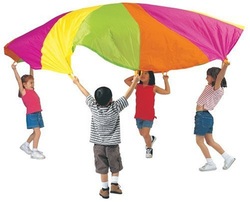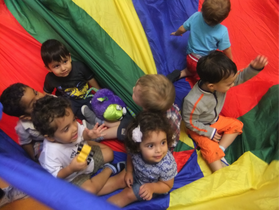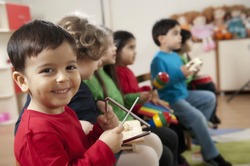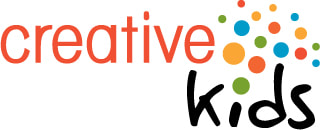Music Moves . . .
An Early Childhood Music Program
Click here to visit Music Moves for Kids Website
Introduction and Philosophy

Children are naturally fascinated with sound and movement play as they teach themselves how to function in the world. Moreover, each child born on this earth has the potential to learn music. Without early, sequential music development guidance, however, the potential for true music understanding and enjoyment is left underdeveloped in most children.
Music Moves . . . is a musical approach that is based on the groundbreaking book A Music Learning Theory for Newborn and Young Children (Edwin E. Gordon, GIA Publications, Inc., 1997) as well as years of practical and experimental research. Music Moves . . . is designed to assist young children in their development of basic music skills such as singing, rhythm chanting, and moving.
By using this sequenced series of music and movement activities your child will discover the pure delight of playing music and movement games. As a parent or child caregiver you will learn how to provide a rich music environment for them, how to listen to and understand the sounds they make, and how to reinforce each child’s music and movement creativity through imitation and improvisation using audiation (the ability each of us has to think music). Consequently, you will lay the foundation for a lifetime of music and movement participation, understanding, and enjoyment for the children in your care.
Music Moves . . . incorporates songs, rhythm chants and movement activities to assist in organizing sequential music and movement experiences for newborn and young children.
Music Moves . . . is a musical approach that is based on the groundbreaking book A Music Learning Theory for Newborn and Young Children (Edwin E. Gordon, GIA Publications, Inc., 1997) as well as years of practical and experimental research. Music Moves . . . is designed to assist young children in their development of basic music skills such as singing, rhythm chanting, and moving.
By using this sequenced series of music and movement activities your child will discover the pure delight of playing music and movement games. As a parent or child caregiver you will learn how to provide a rich music environment for them, how to listen to and understand the sounds they make, and how to reinforce each child’s music and movement creativity through imitation and improvisation using audiation (the ability each of us has to think music). Consequently, you will lay the foundation for a lifetime of music and movement participation, understanding, and enjoyment for the children in your care.
Music Moves . . . incorporates songs, rhythm chants and movement activities to assist in organizing sequential music and movement experiences for newborn and young children.
Music Development and Music Moves . . .

One’s potential to learn is never greater than at the moment of birth. (MLTNYC, 1:1) The early years of life are crucial for establishing a foundation for lifelong music development. A child’s musical experiences from birth to age five have a particularly profound impact on the extent to which your child will be able to understand, appreciate, and achieve in music as an adult. Children must be exposed to a rich variety of music during these years in order to develop the necessary readiness for formal music learning when they are older.
Children learn music in much the same way they learn a language. After listening to the sounds of their native language for many months, a child goes through a stage of language babble, in which they experiment with speech sounds that do not make sense to adult listeners. Soon afterwards, they “break the code” of their language and are able to first imitate words, and then use them meaningfully in phrases and sentences of their own.
Children also go through stages of music babble, in which they make sounds that typically do not make musical sense to adults. In tonal babble the child sings in a speaking voice quality. In rhythm babble she moves erratically, without consistent tempo or discernible meter.
Children who have not yet emerged from music babble do not benefit from formal music instruction. They should not be taught as if they are young adults or kindergarten children. Parents and teachers should instead informally guide them to an understanding of music just as they informally guide them to an understanding of their spoken language before they receive formal schooling.
Guidance and Instruction
All guidance is informal in nature, because the parent or teacher does not impose information and skills upon the child. Rather, the child is exposed to their culture and encouraged to absorb that culture. Nothing specific is expected or demanded from children in terms of their musical responses.
There are two types of informal guidance. In unstructured informal guidance, which is appropriate from birth to approximately age three, the parent or teacher does not plan specifically what the child will say and do. In structured informal guidance, which should take place roughly between ages three and five, the parent or teacher does plan specifically what the child will say and do, but does not expect specific responses from the child.
Formal instruction should normally commence at age five, when the child enters kindergarten. In formal instruction, in addition to the parent or teacher specifically planning what will be taught, teaching is organized into allotted time periods, and cooperation, including specific types of responses, is expected of the child.
Children learn music in much the same way they learn a language. After listening to the sounds of their native language for many months, a child goes through a stage of language babble, in which they experiment with speech sounds that do not make sense to adult listeners. Soon afterwards, they “break the code” of their language and are able to first imitate words, and then use them meaningfully in phrases and sentences of their own.
Children also go through stages of music babble, in which they make sounds that typically do not make musical sense to adults. In tonal babble the child sings in a speaking voice quality. In rhythm babble she moves erratically, without consistent tempo or discernible meter.
Children who have not yet emerged from music babble do not benefit from formal music instruction. They should not be taught as if they are young adults or kindergarten children. Parents and teachers should instead informally guide them to an understanding of music just as they informally guide them to an understanding of their spoken language before they receive formal schooling.
Guidance and Instruction
All guidance is informal in nature, because the parent or teacher does not impose information and skills upon the child. Rather, the child is exposed to their culture and encouraged to absorb that culture. Nothing specific is expected or demanded from children in terms of their musical responses.
There are two types of informal guidance. In unstructured informal guidance, which is appropriate from birth to approximately age three, the parent or teacher does not plan specifically what the child will say and do. In structured informal guidance, which should take place roughly between ages three and five, the parent or teacher does plan specifically what the child will say and do, but does not expect specific responses from the child.
Formal instruction should normally commence at age five, when the child enters kindergarten. In formal instruction, in addition to the parent or teacher specifically planning what will be taught, teaching is organized into allotted time periods, and cooperation, including specific types of responses, is expected of the child.
Preparatory Audiation
The musical thinking of children who have not emerged from music babble is called preparatory audiation. Children in preparatory audiation should receive unstructured and structured informal guidance in music.
There are three types of preparatory audiation.
Acculturation is fundamental to children’s musical development. It takes place as children absorb the music of their culture. Gradually they learn to distinguish the sounds in their environment from the sounds that they themselves produce. Then they learn to discriminate among sounds in their environment.
Imitation. In musical imitation the childs musical actions become more purposeful than in the stages of acculturation. Whether their attempt to imitate is correct or incorrect, a child profits greatly from engaging in music imitation. The child begins to learn how to teach music to themself.
Assimilation. During the assimilation type of preparatory audiation the child starts to become aware of musical syntax. The child learns to perform patterns with some precision as they coordinate and assimilate the imitation of those patterns with the movement of their body and muscles.
The musical thinking of children who have not emerged from music babble is called preparatory audiation. Children in preparatory audiation should receive unstructured and structured informal guidance in music.
There are three types of preparatory audiation.
Acculturation is fundamental to children’s musical development. It takes place as children absorb the music of their culture. Gradually they learn to distinguish the sounds in their environment from the sounds that they themselves produce. Then they learn to discriminate among sounds in their environment.
Imitation. In musical imitation the childs musical actions become more purposeful than in the stages of acculturation. Whether their attempt to imitate is correct or incorrect, a child profits greatly from engaging in music imitation. The child begins to learn how to teach music to themself.
Assimilation. During the assimilation type of preparatory audiation the child starts to become aware of musical syntax. The child learns to perform patterns with some precision as they coordinate and assimilate the imitation of those patterns with the movement of their body and muscles.
- Introspection. In this stage the child learns to compare what she is performing with how she is moving. She must discover for herself that the patterns she is performing are not coordinated with her movement. This stage is crucial to the development of audiation, because she must be able to coordinate musically with herself before she can be expected to coordinate musically with someone else.
- Coordination. In this stage the child learns to coordinate her singing of tonal patterns with her muscular movement and breathing, and her chanting of rhythm patterns with her muscular movement and breathing. She is able to learn to audiate as she listens to, performs, reads, writes, creates, and improvises music.

Music Moves . . . . Classes
There are five possible classes for students to attend. Each child should be accompanied by at least one parent or caregiver to attend a 30 - 40 minute session, once a week, for 10 weeks. Classes are set by age:
Music Moves . . . for Infants: Ages newborn to 12 months
Music Moves . . . for Toddlers: Ages 1 and 2 years
Music Moves . . . for Pre-School: Ages 3 and 4 years
Music Moves . . . for Families: A mixed age group from newborn to age 4. This class is especially beneficial with families with more than one child attending Music Moves . . .
Music Moves Keyboard Games: Ages 4 and 5. Includes time at the piano.
Music Moves for Piano: Ages 5 and up. Click here for further information on Music Moves for Piano
There are five possible classes for students to attend. Each child should be accompanied by at least one parent or caregiver to attend a 30 - 40 minute session, once a week, for 10 weeks. Classes are set by age:
Music Moves . . . for Infants: Ages newborn to 12 months
Music Moves . . . for Toddlers: Ages 1 and 2 years
Music Moves . . . for Pre-School: Ages 3 and 4 years
Music Moves . . . for Families: A mixed age group from newborn to age 4. This class is especially beneficial with families with more than one child attending Music Moves . . .
Music Moves Keyboard Games: Ages 4 and 5. Includes time at the piano.
Music Moves for Piano: Ages 5 and up. Click here for further information on Music Moves for Piano
|
To download the above information as a brochure, click to the right.
|
| ||||||
For more information on this approach, or to register for for a class, please feel free to email me for further information.
|
Gregory Chase Music Studio is proud to work with Creative Kids Saskatchewan.
For families unable to meet the lesson fees, funds may be available from Creative Kids Saskatchewan. Visit www.CreativeKidsSask.ca for details. |
